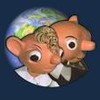Just So Stories (Příběhy jen tak, 2002)
Rudyard Kipling. Audiokniha. Produkce John Tydeman. Režie Mark Smith. Střih Mark Etherden.
Čte Geoffrey Palmer
Vydal Naxos Audiobooks Ltd. v roce 2002 (3 MC; ISBN 978-962-634-250-3; 62 + 68 + 77 min.). Booklet zde.
Obsah:
MC 1
How the Whale got his Throat 6:52
– ‘When the cabin port-holes are dark green’ 1:00
How the Camel got his Hump 5.46
– ‘The Camel’s hump is an ugly hump’ 1:32
How the Rhinoceros got his Skin 5:30
– ‘This Uninhabited Island’ 3:38
How the Leopard got his Spots 13:07
– ‘“Now come along…”’ 1:55
The Elephant’s Child 8:53
– ‘Then the Elephant’s Child sat back on his
little haunches, and pulled…’ 8:09
– ‘Keep six honest serving-men…’ 0:59
The Sing-Song of Old Man Kangaroo 6:44
– ‘This is the mouth-filling song…’ 1:27
The Beginning of the Armadillos 7:26
– ‘“That was a very narrow escape,” said
Stickly-Prickly.’ 10:11
‘I’ve never sailed the Amazon.’ 1:16
MC 2
How the First Letter was Written 12:15
– ‘As soon as Teshumai saw the picture she
screamed like anything…’ 9:06
– ‘There runs a road by Merrow Down – …’ 1:41
How the Alphabet was Made 8:35
– ‘“Now look,” said her Daddy. “’S’pose you
saw this…”’ 9:44
– ‘Then the carp-mouth open.’ 6:04
– ‘And after thousands and thousands and
thousands of years…’ 1:02
– ‘Of all the tribe of Tegumai…’ 1:23
The Crab that Played with the Sea 7:11
– ‘Then all the beasts, birds and fishes said
together, “Eldest Magician…”’ 5:46
– ‘“Now,” said the Magician, “make a Magic
Pau Amma…”’ 10:07
‘CHINA-GOING P’s and O’s…’ 2:09
MC 3
The Cat that Walked by Himself 5:34
– ‘When the Man waked up…’ 4:28
– ‘Next day, the Cat waited to see if any other
Wild thing…’ 6:02
– ‘O my Enemy and Wife of my Enemy…’ 5:48
– ‘That evening when the Man and the Dog came
into the Cave…’ 3:48
– ‘Pussy can sit by the fire and sing…’ 1:27
The Butterfly that Stamped 3:56
– ‘He married ever so many wives…’ 3:23
– ‘Presently two Butterflies flew under the tree
quarrelling.’ 7:31
– ‘Then the Butterfly stamped…’ 1:44
– ‘Suleiman-bin-Daoud could hardly speak for
laughing.’ 6:35
– ‘There was never a Queen like Balkis…’
Lit.: Soames, Nicola: Rudyard Kipling: Just So Stories. In booklet MC, 2002 (článek). – Cit.: Rudyard Kipling first told these stories to his own children. The full title is Just So Stories for little children – and were called that because, he said, they had to be told ‘just so’. He told them to his daughter Elsie and his son Charles. He had a deep, smooth voice and he regarded them very much as bedtime stories which would help the children go to sleep.
They were first published in 1902. This was after The Jungle Books (1894 and 1895), the stories of Mowgli and Rikki- Tikki-Tavi and others which remain among the most loved children’s stories of all time. But he started to tell them as stories many years before. While he was writing the Just So Stories, his daughter Josephine died of pneumonia at the age of six. Kipling himself caught it and was also very ill. This stopped him writing for months, but when he recovered he returned to them. The poem Merrydown in How the Alphabet was Made was written in memory of Josephine.
Kipling was born in Bombay in India in 1865, and though he went to school in England (having an unhappy time separated from his parents) he went back to India as a young man working as a journalist. He was a great traveller throughout his life, going round the world by train and by paddle steamer (some of these boats crossing the Atlantic and the Pacific at the time had sails as well as paddles). He spent time in Africa and the Middle East, as well as Australia and New Zealand.
His experience of these many countries and many cultures can be seen in the Just So Stories. Many of them are not set in any particular country, but they bear the hallmark of Africa, the Middle East and the Far East. The Whale is set, ‘Fifty North and Forty West’, in the middle of the Atlantic. The Kangaroo is clearly marked Australia, and the Rhinoceros is on an island in the Red Sea (a fictional island). The grumpy camel lives in the middle of a Howling Desert – though Arabia is suggested and Djinns come from Arabian mythology. Nevertheless, this is mythical country, because the punchayet which is mentioned means ‘a council of five’, a term from India.
The Leopard lives in the High Veldt of South Africa, with the Wise Baviaan, the dog-headed Baboon, ‘Quite the Wisest Animal in All South Africa’. So the Ethiopian is clearly a long way from home. It is interesting to notice that in the picture of Baviaan, Kipling has drawn many different scripts, including Amaric or Coptic (from Ethiopia), Hieroglyphic (from Egypt), Cuneiform (from Babylon), as well as Bengalic (from India), Burmic (from Burma) and Hebraic (from Israel). So the story covers a very wide range of countries!
African elephants are different to Indian elephants – they are much bigger for a start – and some experts have said that Kipling’s drawing looks more like an Indian elephant.
However, Kipling’s Elephant’s Child with ‘‘satiable curtiosity’ finds his crocodile on the banks of the great grey-green, greasy Limpopo River, and he had to go through Khama’s country (which is Botswana in Africa) to get there. So that is a mixture. For the Armadillo story, we move to the banks of the ‘turbid Amazon’, the longest river in South America. For the Alphabet stories, we are in Neolithic times – which means the later Stone Age (‘lithic’ means stone in Greek).
Where is the Crab that Played with the Sea? Somewhere around India and Malaya and Indonesia, probably, according to the names. Kipling may have imagined The Cat that Walked by Himself in America, where he once lived, because of the ‘wild rice and wild grenadillas’, but it doesn’t really matter.
There is no doubt, however, about the Butterfly that Stamped, for Suleiman-bin- Daoud had his temple in Jerusalem. It was a very famous building. The Just So Stories range around the globe – which, for Kipling, was home. He loved travelling. And just listening to them, we too can travel around the globe in our imagination, to deserts, jungles, forests, oceans, to times past and times before past.
If you enjoyed this post, please consider to leave a comment or subscribe to the feed and get future articles delivered to your feed reader.






Komentáře
Zatím nemáte žádné komentáře.
Napište komentář k článku